Some of the links on this page contain affiliate links. Renaissance Path is a participant in the Amazon Associates Program, an affiliate advertising program that provides a way for websites to earn advertising fees by linking to products. We only link to products we normally use and trust. When you purchase an item through the link we receive a small commission at no additional cost to you. This helps pay for the costs associated with running this blog. Your support is greatly appreciated. Thank You!
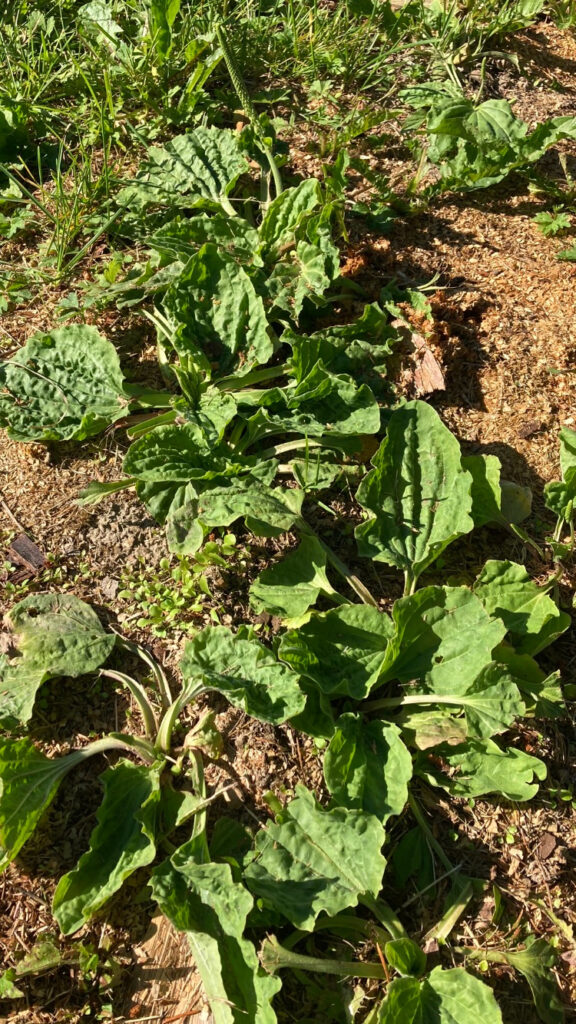
I bet you could go outside in your yard and you’d find plantain. But did you know it isn’t just an annoying weed coming up in your yard and driveway? It is a wild edible and is used in herbal medicine.
There are several varieties of Plantain. The two I see in the Pacific Northwest are Plantago major (broadleaf plantain) and Plantago lanceolata (narrow-leaf plantain).
Plantain is a plant native to Europe and parts of Asia. This plantain is not the same as Plantains in the banana family.
Here are some of the Plantain Varieties
- narrowleaf plantain (Plantago lanceolata)
- buck’s-horn plantain (Plantago coronopus)
- bracted plantain (Plantago aristata)
- Chinese plantain (Plantago asiatica)
- blond plantain (Plantago ovata)
- blackseed plantain (Plantago rugelii)
- Woolly plantain (Plantago patagonica)
- Broad-leaf (Plantago major)
Identification
Broadleaf Plantain has egg-shaped green leaves that grow in a rosette. Plantain leaves have string-like veins just like celery does.
Plantain has a long leafless flower spike that consists of tiny green flowers all the way up the spike. It is about the size of a pencil.
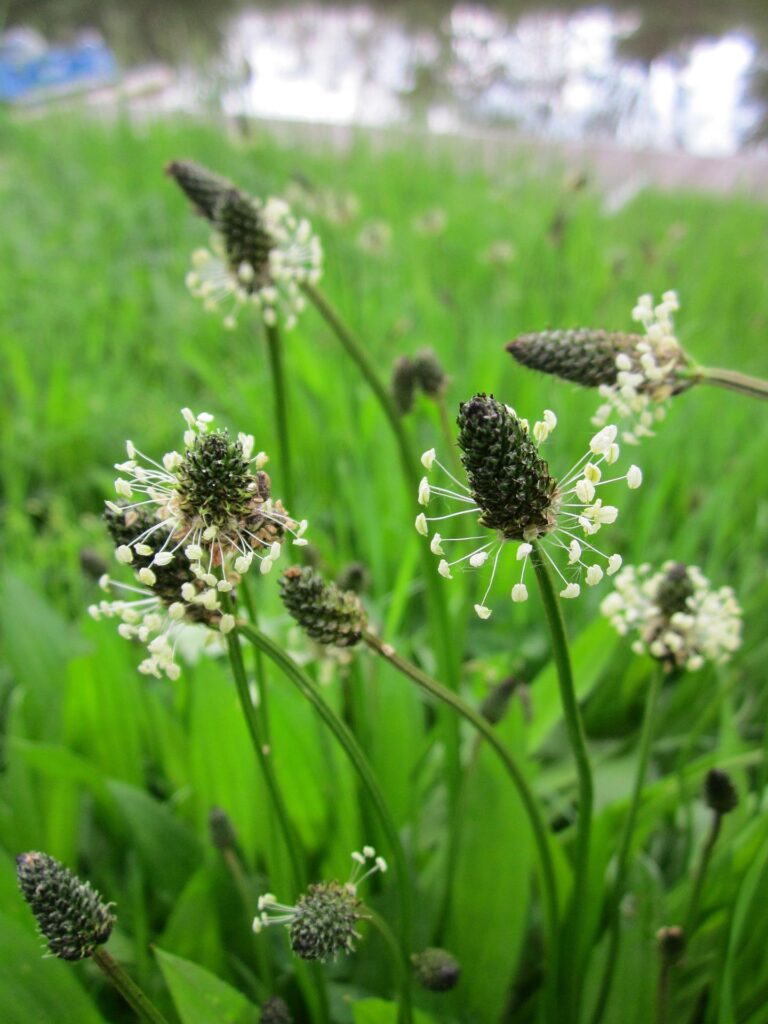
Narrow-leaf Plantain the leaves are long and narrow, lanceolate shaped, and have ribs(veins) running from the base of the leaf to the tip. Leaves are arranged in a basal rosette.
The stem is square and hairless.
Tiny white flowers are densely packed on a cylindrical spike.
Other Names for Plantain Major
- Cuckoo’s Bread
- Doorweed
- Dooryard Plantain
- Englishman’s Foot
- Great Plantain
- Ripple Grass
- Roundleaf Plantain
- Snake Plant
- Snakeweed
- Waybread
- Waybroad
- Whiteman’s Foot
Other Names for Plantago lanceolata
- English plantain
- Narrow-leaved plantain
- Buckhorn plantain
- Ribwort
- Lanceleaf plantain
- Ribgrass
History of Plantain and its Medicinal Uses
Plantain has been used for thousands of years. In fact Pedanius Dioscorides, an ancient Greek Physician and the founder of the Materia Medica wrote about plantain in the 1st Century. The Materia Medica is a body of collected knowledge about herbs and plants and their therapeutic healing properties.
Scientists believe Plantago major has existed for nearly 4000 years in Europe, America, and Asia.
Vikings used plantain for wound healing. In Scandinavia plantain is known for its wound-healing properties. The Swedish and Norwegian called plantain groblad meaning ‘healing leaves’.
Plantain was mentioned in The Nine Herbs Charm, an Old English charm recorded in the tenth century CE by the Anglo-Saxons. It’s believed the nine herbs included in this charm were given to the people by Woden, the God of healing.
Plantain is even mentioned in the story of Romeo and Juliet.
Plantain can be used for many ailments like cuts, bruises, burns, insect and bee stings, acne, abscesses and wounds.
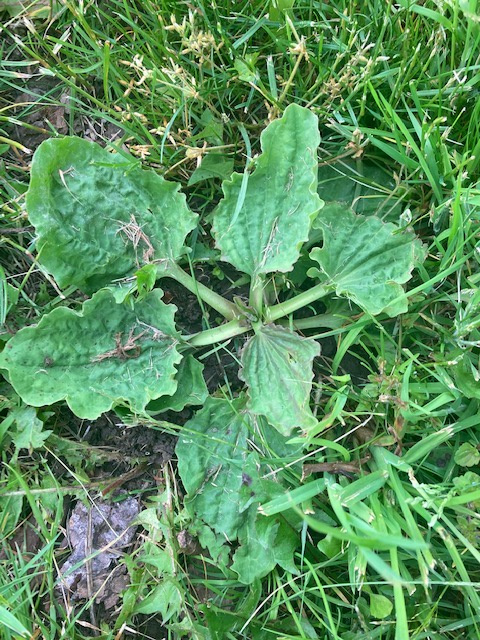
Plantain Active Compounds and Properties
Flavonoids, polysaccharides, terpenoids, lipids, iridoid glycosides, and caffeic acid derivatives.
Flavonoids have been shown to regulate cellular activity and protect the body from oxidative stress and damage. They also have anti-inflammatory benefits, help with pain and inflammation, and are great for the skin.
Polysaccharides are prebiotics. Polysaccharides are great for digestion, they slow gastric emptying, and improve the immune system function.
Terpenoids are shown to have anticancer properties.
Lipids in plants are naturally occurring fatty acids. Lipids’ main functions in the body are storing energy, helping with digestion and increasing bioavailability. Also signaling, protecting, and insulating.
Iridoid glycosides are hepatoprotective(protect the liver), neuroprotective(brain), hypoglycemic(lowering blood sugar), anti-inflammatory, anti-tumor, and hypolipidemic(cholesterol lowering).
Caffeic acid can help with inflammation, and diabetes and has been shown to help with exercise-induced fatigue. As well as showing prevention against neurodegenerative diseases like Alzheimers.
Medicinal Properties of Plantain
Vulnerary-Wound healing
Expectorant-Helps expel and clear mucus from airway.
Astringent-Tightening of skin and other tissues and organs.
Anti-inflammatory-Reduces inflammation and swelling.
Demulcent-Relieves inflammation and irritation of mucus membranes by creating a protective soothing film.
Diuretic-Helps rid your body of excess sodium and salt by excretion.
Antiseptic-Stops the growth of microorganisms and helps reduce infection.
Alterative-Opens the channels of elimination and helps to restore balance and proper bodily functioning.
Hepatoprotective-Helps prevent liver damage. Hemostatic-Stopping hemorrhaging(blood loss).
Analgesic-Pain relieving.
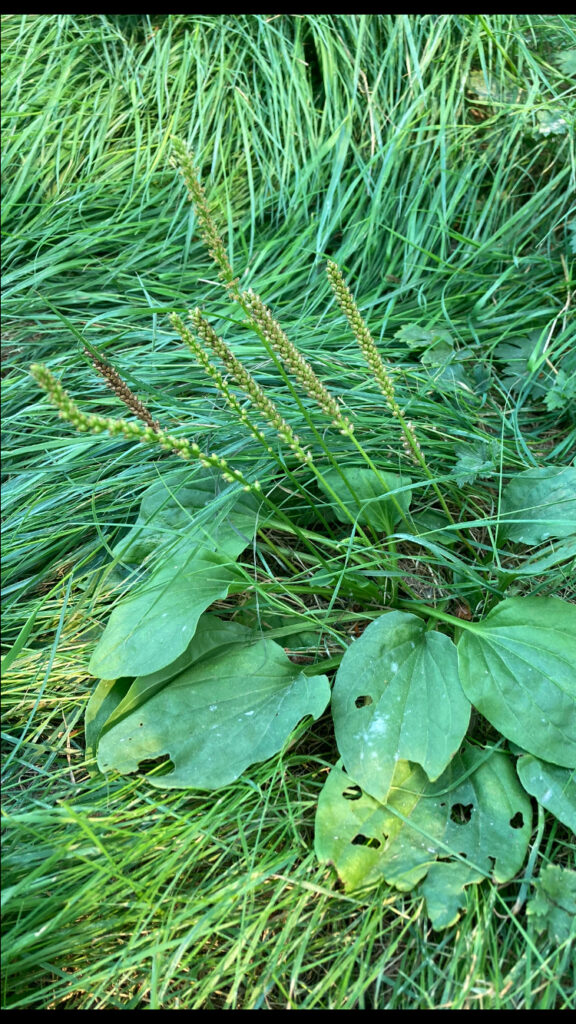
Plantain Uses and Benefits
Plantain seed contains 30% mucilage which swells up in the gut and can soothe inflammation in the bowels.
It has high fiber content and can help bulk up stools. It can help with constipation and also diarrhea(1).
Can help soothe sore throats due to its mucilage content.
Mashed and cut-up leaves placed on boils and abscesses can help promote suppuration(draining of pus).
Leaf poultice is good for blisters, sores, cuts, and insect stings. It is an all-around great wound healer(2).
You can make a strong tea/infusion from the plantain leaves and spray the infusion on sunburt skin.
Place a leaf poultice on burns it is very soothing.
Plantain can be helpful for hemorrhoids. You can make a plantain-infused oil and use that oil to make a salve or hemorrhoid suppositories.
P. Major is immune boosting. It has a compound called plantamajoside. Plantamajoside is similar to echinacoside, a compound found in Echinacea that has immune-modulating activity.
P. Major was shown in animal studies to be effective for pain relief as it has anti-inflammatory and analgesic activities(3).
Plantain was shown to have strong anti-cancer properties. In a study of C3H mice that have a 90% incidence of mammary tumors were given daily injections of Plantago major. The controls were given nothing. The Control group had a 93% incidence of mammary tumors and the treated mice had an 18.2% incidence of tumors. That was a significant difference (4).
Two grams daily of Plantain l. seeds were shown in this study here to improve aspartate aminotransferase, alanine aminotransferase, and improved serum levels of triglycerides in patients with non-fatty liver disease.
Plantago lanceolata tea or tincture has been used for centuries and is a go-to herbal treatment for upper respiratory infections, coughs, and asthma. In fact, there are several studies showing Plantago lanceolata has anti-inflammatory, spasmolytic and immunostimulatory actions (5).
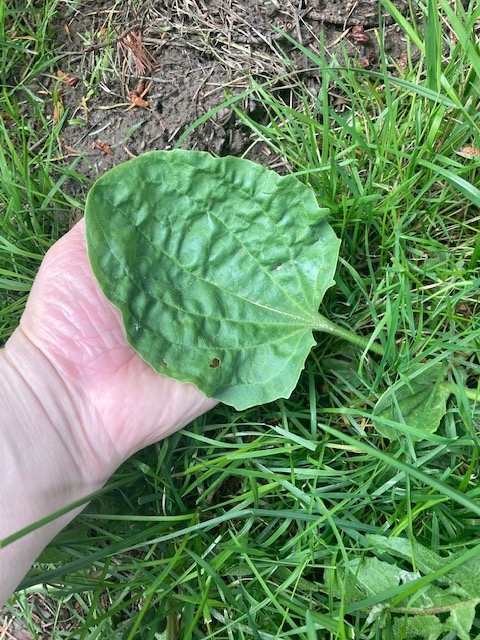
9 Medicinal Uses for Plantain
It can be used in a diaper rash cream or herbal salve.
Makes a great first aid ointment and is also great for wound care and help with healing.
Can be used for asthma or bronchitis. Helps with respiratory issues. It is antitussive and has expectorant abilities.
It can be used for painful earaches. Making an infused ear oil may be helpful.
Can be used as a spit poultice for bee or insect stings.
It can be used to dry out splinters or venom.
Plantain is soothing for skin burns. You can apply plantain poultice directly to the burn to help with pain and it can help with healing.
Plantain tea can help with peptic ulcers. The tea has demulcent properties and is very soothing to an inflamed stomach or intestinal tract.
Another great use for plantain is using it for diarrhea. Plantain contains iridoids that have strong antispasmodic abilities. Iridoids have been shown in studies to be effective for ulcerative colitis.
Studies on Plantain Major
Treatment of Plantain Major for second-degree burns. A study of 15 patients who suffered second-degree burns found that P. Major extract performed almost as well as prescription Silver Sulfadiazine in healing second-degree burn wounds and preventing infection(6).
Plantain is an excellent anti-inflammatory agent and was shown in studies to be as powerful as low-dose aspirin(7).
How to use Plantain
According to the German Commission E when drinking plantain as a tea it can be consumed up to 3 times daily. Tea is prepared using 1/4-1/2 teaspoon of dried plantain leaves and steeping in 1 cup of hot water for 10-15 minutes.
For coughs, the German Commission E recommends 1/2 teaspoon of tincture up to 3 times daily.
For wounds or insect bites, fresh mashed leaves can be applied 3-4 times a day.
Here is a plantain salve recipe from the blog The Hedgecombers.
Where to Buy Plantain
If you can’t forage for plantain safely in your area you can always purchase dried plantain on Amazon or other places like Mountain Rose Herbs.
You can make your own Healing Plantain Salve with dried plantain leaves purchased through Amazon.com
If you have ever wanted to try plantain tea and don’t wanna fuss with picking and drying leaves or having loose-leaf tea you can purchase it online from Amazon.
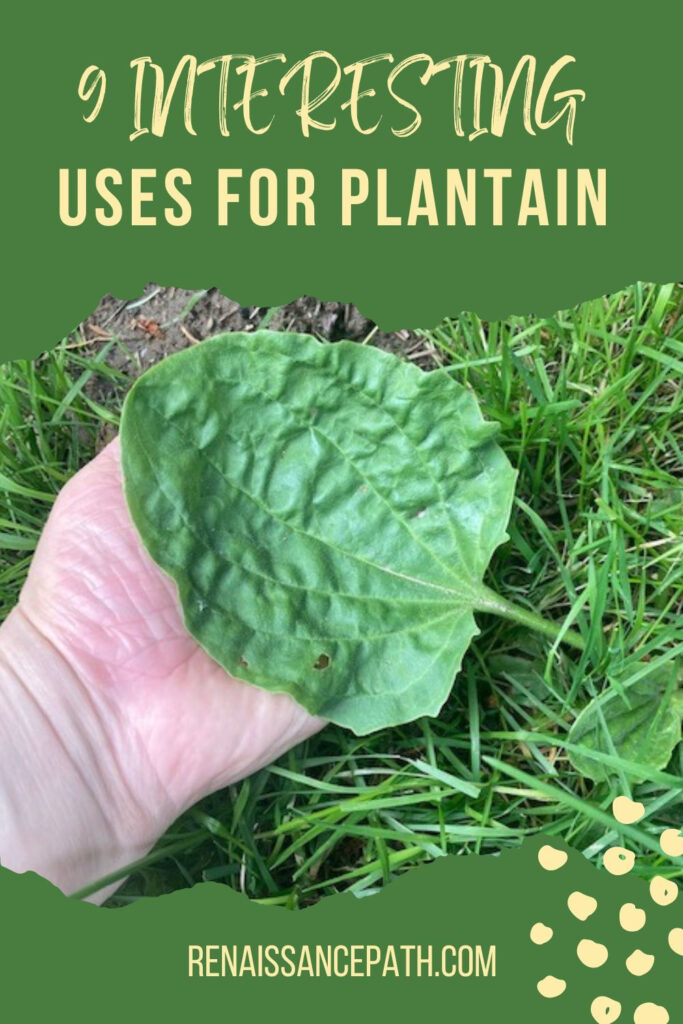
Final Thoughts
Plantain definitely deserves our attention. Plantain is a panacea – a cure for many things. It is definitely a herb I like to keep around at all times. Have you ever used plantain medicinally or eaten it? Let me know in the comments.
Much Love,
Melissa
If you like learning about the healing properties of herbs check out my post here.
This website is for educational purposes only. The information provided by Renaissance Path is not intended to diagnose, treat, or cure any diseases. Please consult a qualified health care professional for medical advice.
Leave a Reply